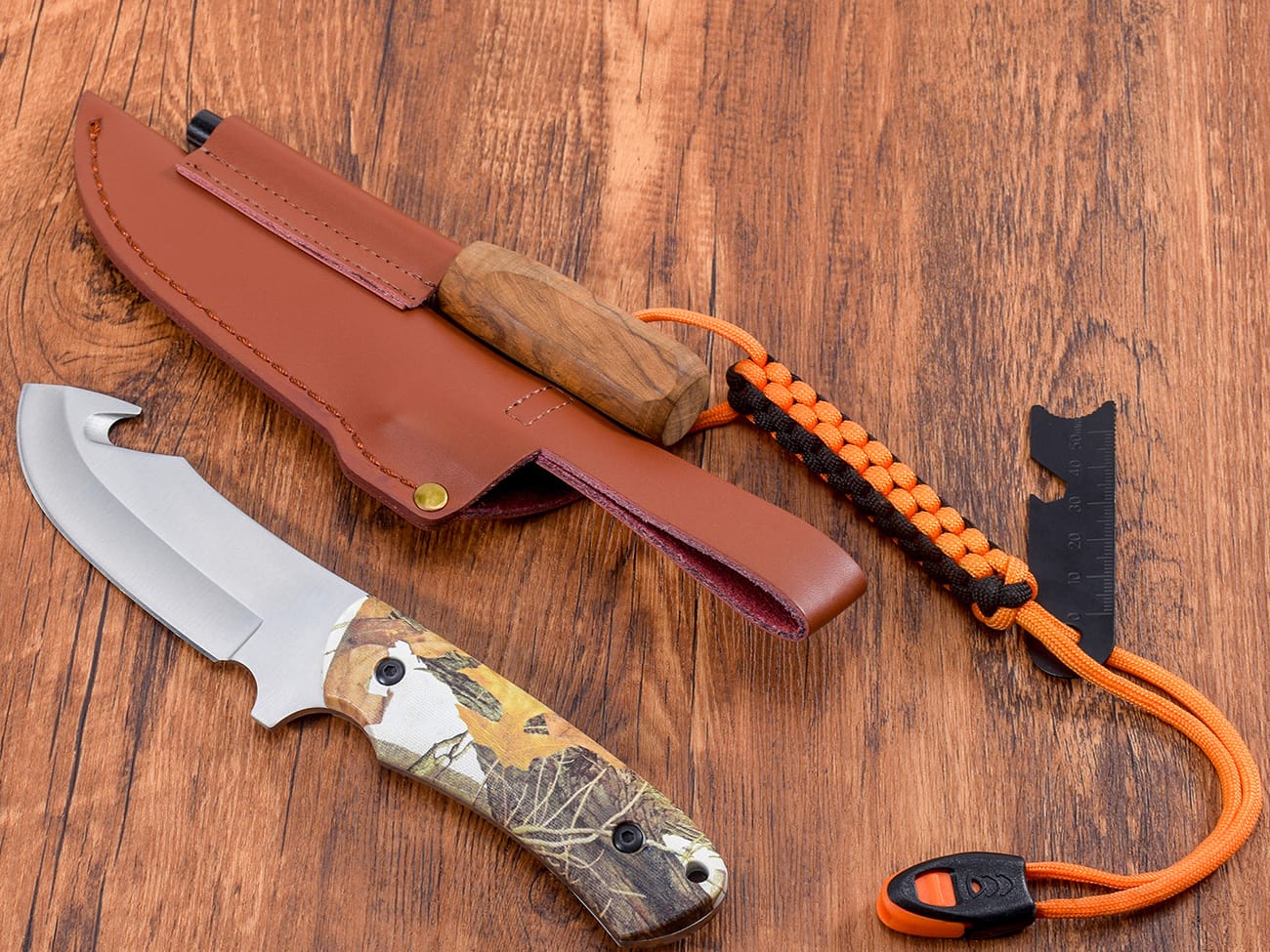Você está em busca da faca ideal para o transporte diário (EDC), mas se sente sobrecarregado pela miríade de opções disponíveis? Um fator crucial que muitas vezes é esquecido é o peso da faca. Neste guia abrangente, vamos nos aprofundar no mundo das facas EDC e explorar o equilíbrio perfeito entre funcionalidade e portabilidade. Seja você um entusiasta experiente de facas ou um novato no cenário EDC, este artigo o equipará com o conhecimento para tomar uma decisão informada sobre o peso apropriado para sua faca EDC.
Por que o peso da faca EDC é importante?
Antes de mergulharmos nos detalhes, vamos abordar por que o peso da sua faca EDC é tão importante. Uma faca EDC bem escolhida deve ser:
- Confortável para transportar diariamente
- Fácil de usar por longos períodos
- Capaz de lidar com várias tarefas
- Discreto no seu bolso ou no seu cinto
O peso da sua faca afeta diretamente todos esses fatores, tornando-se uma consideração crucial no seu processo de seleção de faca EDC.
Qual é a faixa de peso ideal para uma faca EDC?
Quando se trata de facas EDC, não há uma resposta única para todos. No entanto, a maioria dos especialistas concorda que o ponto ideal para o peso de uma faca EDC fica entre 2 a 5 onças (57 a 142 gramas). Essa faixa oferece um bom equilíbrio entre funcionalidade e portabilidade para a maioria dos usuários. Vamos detalhar mais:
- Facas EDC leves: 2-3 onças (57-85 gramas)
- Facas EDC de peso médio: 3-4 onças (85-113 gramas)
- Facas EDC mais pesadas: 4-5 onças (113-142 gramas)
Como o comprimento da lâmina afeta o peso da faca EDC?
O comprimento da lâmina da sua faca EDC desempenha um papel significativo na determinação do seu peso total. Geralmente, lâminas mais longas resultam em facas mais pesadas. Aqui está um guia aproximado:
- Lâminas de 2 a 3 polegadas: normalmente pesam 2 a 3 onças
- Lâminas de 3-4 polegadas: geralmente ficam na faixa de 3-4 onças
- Lâminas de 4+ polegadas: geralmente pesam 4 onças ou mais
Tenha em mente que a espessura da lâmina e os materiais também contribuem para o peso total. Por exemplo, um 3,54 polegadas 8cr13mov aço inoxidável faca dobrável de madeira rosa pode pesar diferente de uma faca de tamanho similar com cabo de titânio e lâmina de aço D2.
Qual o papel dos materiais do cabo no peso da faca EDC?
O material do cabo da sua faca EDC pode impactar significativamente seu peso. Aqui estão alguns materiais comuns de cabo e suas características de peso:
- G10: Leve e durável, perfeito para facas EDC
- Titânio: extremamente leve, mas forte, ideal para facas EDC premium
- Aço inoxidável: mais pesado, mas muito durável
- Alumínio: leve e acessível
- Madeira: Varia em peso, acrescenta um visual clássico
Por exemplo, um Faca EDC com cabo G10 personalizado, com trava de revestimento e clipe de bolso pode ser mais leve do que uma faca similar com cabo de aço inoxidável.
Como o design da faca afeta a distribuição de peso?
O design geral de uma faca EDC pode influenciar muito como seu peso é distribuído e como ela se sente na mão. Fatores a serem considerados incluem:
- Formato da lâmina (drop point, tanto, etc.)
- Ergonomia da alça
- Mecanismo de travamento (liner lock, frame lock, etc.)
- Design de clipe de bolso
Uma faca bem projetada parecerá equilibrada e confortável de usar, independentemente do seu peso real. Por exemplo, uma Canivete dobrável com cabo G10 de 3,35 polegadas com trava de eixo e clipe pode parecer mais equilibrado do que uma faca mais pesada com má distribuição de peso.
Quais são as vantagens das facas EDC leves?
Facas EDC leves, geralmente pesando entre 2 e 3 onças, oferecem vários benefícios:
- Fácil de transportar o dia todo sem perceber
- Ideal para ambientes de escritório ou ambientes formais
- Menos fadiga durante uso prolongado
- Geralmente é legal em áreas com leis mais rígidas sobre facas
No entanto, facas ultraleves podem sacrificar alguma durabilidade ou recursos para atingir seu baixo peso.
Quando você pode querer uma faca EDC mais pesada?
Embora facas leves sejam populares, há situações em que uma faca EDC mais pesada (4-5 onças) pode ser preferível:
- Para tarefas pesadas ou uso externo
- Quando você prefere uma sensação mais substancial na mão
- Se você valoriza a durabilidade acima da portabilidade absoluta
- Para fins de autodefesa (quando legal)
UM faca dobrável damasco personalizada com cabo G10 e liner lock pode se enquadrar nessa categoria, oferecendo uma estrutura robusta para tarefas mais exigentes.
Como os diferentes tipos de aço afetam o peso da faca EDC?
O tipo de aço usado na lâmina da sua faca EDC pode impactar seu peso. Aqui está uma rápida visão geral:
- Aços de alto carbono (por exemplo, D2): geralmente mais pesados, mas oferecem excelente retenção de aresta
- Aços inoxidáveis (por exemplo, 8Cr13MoV): Pesos variáveis, boa resistência à corrosão
- Aços premium (por exemplo, S30V): podem ser mais leves, mantendo a resistência
Por exemplo, um Canivete de bolso em aço 8cr13mov com cabo G10 e clipe de bolso pode ser mais leve que uma faca similar feita com aço D2.
Qual é o impacto do peso da faca no transporte diário?
O peso da sua faca EDC pode afetar significativamente sua rotina diária:
- Conforto: Uma faca mais leve é menos perceptível no seu bolso
- Acessibilidade: Facas mais pesadas podem exigir um bolso ou clipe de cinto mais resistente
- Versatilidade: Facas mais leves são mais fáceis de transportar em vários ambientes
- Legalidade: Algumas áreas têm restrições de peso para transportar facas
Considere suas atividades diárias e o ambiente ao escolher o peso da sua faca EDC.
Como escolher o peso certo para sua faca EDC?
Selecionar o peso apropriado para sua faca EDC envolve vários fatores:
- Uso pretendido (tarefas leves vs. trabalho pesado)
- Método de transporte (bolso, cinto, bolsa)
- Preferência pessoal (alguns preferem uma sensação mais substancial)
- Leis e regulamentos locais
- Sua constituição física e força
Tente manusear facas diferentes para ter uma ideia do que funciona melhor para você. A Canivete de bolso com cabo G10 de 3,35 polegadas com lâmina lixada e clipe pode parecer perfeito para uma pessoa, mas muito leve para outra.
Balanceamento de peso e recursos em facas EDC
Ao escolher uma faca EDC, muitas vezes você precisará equilibrar o peso com as características desejadas:
- Os mecanismos de bloqueio adicionam peso, mas aumentam a segurança
- Várias ferramentas (por exemplo, abridores de garrafas) aumentam a versatilidade, mas também o peso
- Lâminas maiores oferecem mais poder de corte, mas acrescentam peso
- Materiais premium podem reduzir o peso, mas aumentar o custo
Considere quais características são mais importantes para você e como elas afetam o peso total da faca.

Principais conclusões: escolhendo o peso certo para sua faca EDC
Para resumir, aqui estão os pontos mais importantes a serem lembrados ao considerar o peso da sua faca EDC:
- A faixa de peso ideal para a maioria das facas EDC é de 2 a 5 onças
- O comprimento da lâmina, os materiais do cabo e o tipo de aço afetam o peso da faca
- Facas mais leves (2-3 oz) são mais fáceis de transportar, mas podem sacrificar a durabilidade
- Facas mais pesadas (4-5 oz) oferecem mais robustez, mas podem ser menos confortáveis de transportar
- Considere suas atividades diárias, leis locais e preferências pessoais ao escolher
- Equilibre os recursos desejados com as considerações de peso
- Experimente facas diferentes para descobrir o que fica melhor na sua mão e no seu bolso
Lembre-se, a faca EDC perfeita é aquela que você realmente carregará e usará todos os dias. Ao considerar o peso juntamente com outros fatores como aço da lâmina, material do cabo e design geral, você estará bem equipado para escolher uma faca EDC que atenda às suas necessidades e se torne uma parte indispensável do seu transporte diário.




